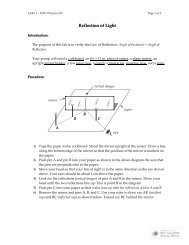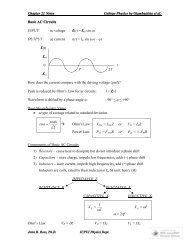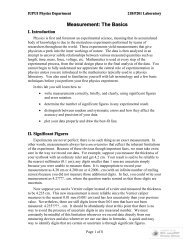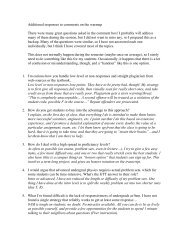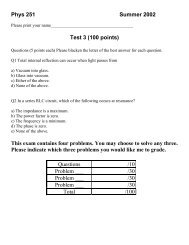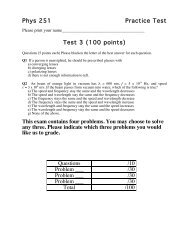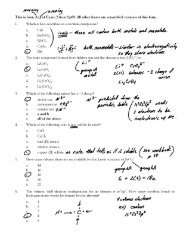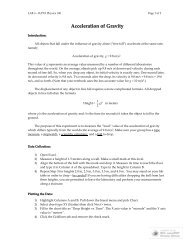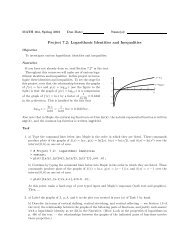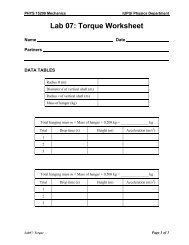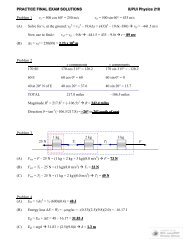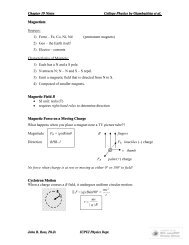Phys 251 Fall 2004 Sample Test 3 - Web Physics
Phys 251 Fall 2004 Sample Test 3 - Web Physics
Phys 251 Fall 2004 Sample Test 3 - Web Physics
You also want an ePaper? Increase the reach of your titles
YUMPU automatically turns print PDFs into web optimized ePapers that Google loves.
<strong>Phys</strong> <strong>251</strong> <strong>Fall</strong> <strong>2004</strong><br />
<strong>Sample</strong> <strong>Test</strong> 3<br />
Questions (5 points each) Please blacken the letter of the best answer for each question.<br />
Q1 Total internal reflection can occur when light passes from<br />
a) Vacuum into glass.<br />
b) Glass into vacuum.<br />
c) Either of the above.<br />
d) None of the above.<br />
Q2 In a series RLC circuit, which of the following occurs at resonance?<br />
a) The impedance is a maximum.<br />
b) The power factor is zero.<br />
c) The frequency is a minimum.<br />
d) The phase is zero.<br />
e) None of the above.<br />
This exam contains four problems, only three may be graded.<br />
You may choose to solve any three. Please indicate which three<br />
problems you would like us to grade. We will grade only the<br />
problems you select.<br />
Questions /10<br />
Problem ___ /30<br />
Problem ___ /30<br />
Problem ___ /30<br />
Total /100
Problems (30 points each). Please show your work and circle your answers.<br />
Missing or incorrect reasoning will earn no credit.<br />
P1 In the circuit shown at right, an inductor a<br />
capacitor and a resistor are connected in series<br />
with an ac source. The values of the inductor<br />
and the capacitor are as shown. The source<br />
produces current I = I max cos(2500t) and<br />
V = 15cos(2500t+π/4).<br />
∼<br />
L = 50 mH<br />
C = 4 µF<br />
Please find<br />
a) The resistance, R.<br />
b) The RMS voltage at the source.<br />
c) The impedance<br />
d) The power factor<br />
R
P2 An linearly polarized electromagnetic plane wave in vacuum has an electric field described by<br />
the equation:<br />
r<br />
Eyt ( , )= 10 4 kˆsin( 10<br />
14 t+<br />
ky )<br />
Please answer each of the following questions:<br />
a) What is the wavelength of this wave?<br />
b) What is the angular frequency of this wave?<br />
c) What is the direction of motion of this wave?<br />
d) What is the B field associated with this wave<br />
e) If this wave were to enter a piece of glass with index of refraction 1.55, what would be the<br />
wavenumber of the wave in glass?
P3 Light enters an equilateral triangular prism at<br />
an angle θ i to the normal. The index of refraction<br />
of the glass is n = 1.5. The refracted beam<br />
undergoes total internal reflection at point A then<br />
exits the prism at point B. Please find.<br />
θ i<br />
a) The angle between the exiting beam and the<br />
normal to the bottom face if θ i = 20°.<br />
b) The maximum value of θ i .<br />
A<br />
B
P4 A lens with f = -30 cm is placed 45 cm to the right of a plane mirror. An object is placed<br />
between them, 20 cm from the lens. A viewer on the right will see two images. Please answer<br />
each of the following.<br />
a) Is this a converging or a diverging lens?<br />
b) What is the focal length of the mirror?<br />
c) How far from the lens is each of the images?<br />
d) Are the images both real, both virtual or one of each?



